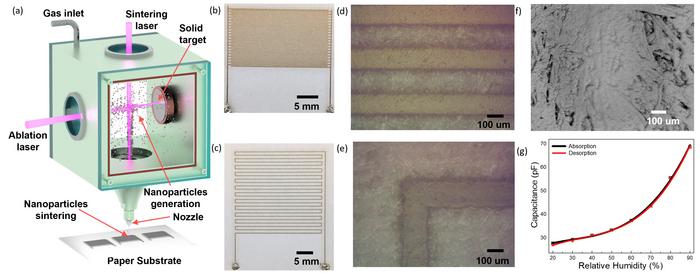In the vast landscape of agricultural innovation, particularly within the realm of smart technology, the need for sustainable practices is becoming increasingly crucial. As the global population continues to soar, the pressure on food production systems intensifies; thus, advancements in sensor technology are propelling the agricultural sector into a new era of efficiency and environmental consciousness. Researchers at Auburn University have taken significant strides in developing eco-friendly sensors aimed at revolutionizing greenhouse management and food storage practices.
The emergence of smart sensor technology has fundamentally changed how agricultural producers monitor and control environmental variables critical for crop health, particularly temperature and humidity. In the face of unpredictable weather patterns and climate change, the urgency to innovate has never been greater. The introduction of paper-based temperature and humidity sensors, created through a technique called dry additive nanomanufacturing, underscores a remarkable fusion of technology with ecological responsibility.
Traditional sensors often rely on plastic-based materials, which contribute to the growing problem of electronic waste. Researchers have sought to find a sustainable alternative, one that can deliver high accuracy and functionality without compromising environmental integrity. Consequently, the exploration of cellulose fibers as a medium for sensor construction has surfaced as a promising solution, addressing waste and pollution issues while maintaining performance standards.
The process of dry additive nanomanufacturing allows for precise control over the production of these sensors. By employing this technique, researchers print silver lines onto various biodegradable paper substrates. This novel approach not only enhances flexibility in manufacturing but also ensures that the sensors retain their effectiveness in monitoring crucial parameters in agricultural environments.
As these sensors engage with moisture in the air, they exhibit changes in capacitance, which corresponds directly to shifts in humidity levels. This relationship is critical, as maintaining optimal humidity is essential for crop growth and post-harvest storage. The reliability of these printed sensors in detecting minute fluctuations in environmental conditions offers farmers an unprecedented level of insight and control over their cultivation practices.
Moreover, the temperature-sensing mechanism integrated into these sensors functions through alterations in resistance. The interplay between increasing temperature and its effects on resistivity allows for continuous monitoring, which is critical to preemptively address conditions that could adversely impact crop yields. This dual capability of the sensors ensures comprehensive environmental monitoring, empowering farmers with real-time data to make informed decisions.
The sensors developed by the research team have demonstrated impressive sensitivity across a range of humidity levels, accurately detecting changes from a relative humidity of 20% to 90%. Additionally, their temperature monitoring capability spans from 25°C to 50°C, rendering them suitable for a variety of agricultural climates. The tunability of these sensors means that they can adapt to different growing conditions and agricultural needs, further enhancing their utility.
One of the greatest advantages of these biodegradable sensors is not only their effectiveness but also their cost-efficiency. Traditional electronic sensors can carry hefty price tags, often making them less accessible for smaller farms or local producers. In contrast, the affordability of these paper-based sensors opens the door for broader adoption, thereby supporting sustainable practices across diverse agricultural settings.
Once their lifecycle is complete, these sensors offer a safe disposal solution as they are biodegradable. The ability to recycle agricultural technology aligned with environmental stewardship represents a significant advancement in sustainability within the agricultural sector. This innovation addresses not only the immediate needs of farmers but also the long-term ramifications of agricultural waste.
Mahjouri-Samani’s research marks a turning point in the application of smart technology for precision agriculture. By integrating advanced printing techniques with biodegradable materials, the research showcases a forward-thinking approach that acknowledges the urgent need for environmentally responsible agricultural technology. This synthesis of innovation and ecological mindfulness offers the potential to shape the future of food production, directly influencing practices in smart farming.
Furthermore, the research emphasizes a collective responsibility to advance agricultural technology that minimizes negative ecological footprints while maximizing productivity. As the agricultural sector faces unprecedented challenges due to climate change and market demands, it is innovations like these that will pave the path toward resilience and sustainability.
With the publication of the article titled “Laser-assisted dry printing eco-friendly paper-based humidity and temperature sensors” in the esteemed Journal of Laser Applications, the research team not only contributes to the scientific community but also inspires agricultural practitioners to rethink their technology choices. This pivotal advance harnesses the power of cutting-edge research aimed at intensifying agricultural efficiency while fostering an environment of sustainability.
As the need for innovative agricultural technologies grows, the integration of eco-friendly materials and advanced manufacturing processes will be critical in shaping future practices. The work being done at Auburn University exemplifies how the merger of science and industry can yield groundbreaking results that cater to the pressing demands of modern agriculture while upholding our commitment to the planet.
Subject of Research: Eco-friendly paper-based temperature and humidity sensors
Article Title: Laser-assisted dry printing eco-friendly paper-based humidity and temperature sensors
News Publication Date: 21-Jan-2025
Web References: DOI: 10.2351/7.0001652
References: Journal of Laser Applications
Image Credits: Masoud Mahjouri-Samani
Keywords: Sensors, Printing, Environmental Monitoring, Food Production
Tags: Agricultural InnovationBiodegradable SensorsDry Additive NanomanufacturingEco-Friendly SensorsElectronic Waste ReductionEnvironmental MonitoringGlobal Food SecurityLaser-Assisted PrintingPaper-Based TechnologyPrecision FarmingSmart AgricultureSustainable Technology





